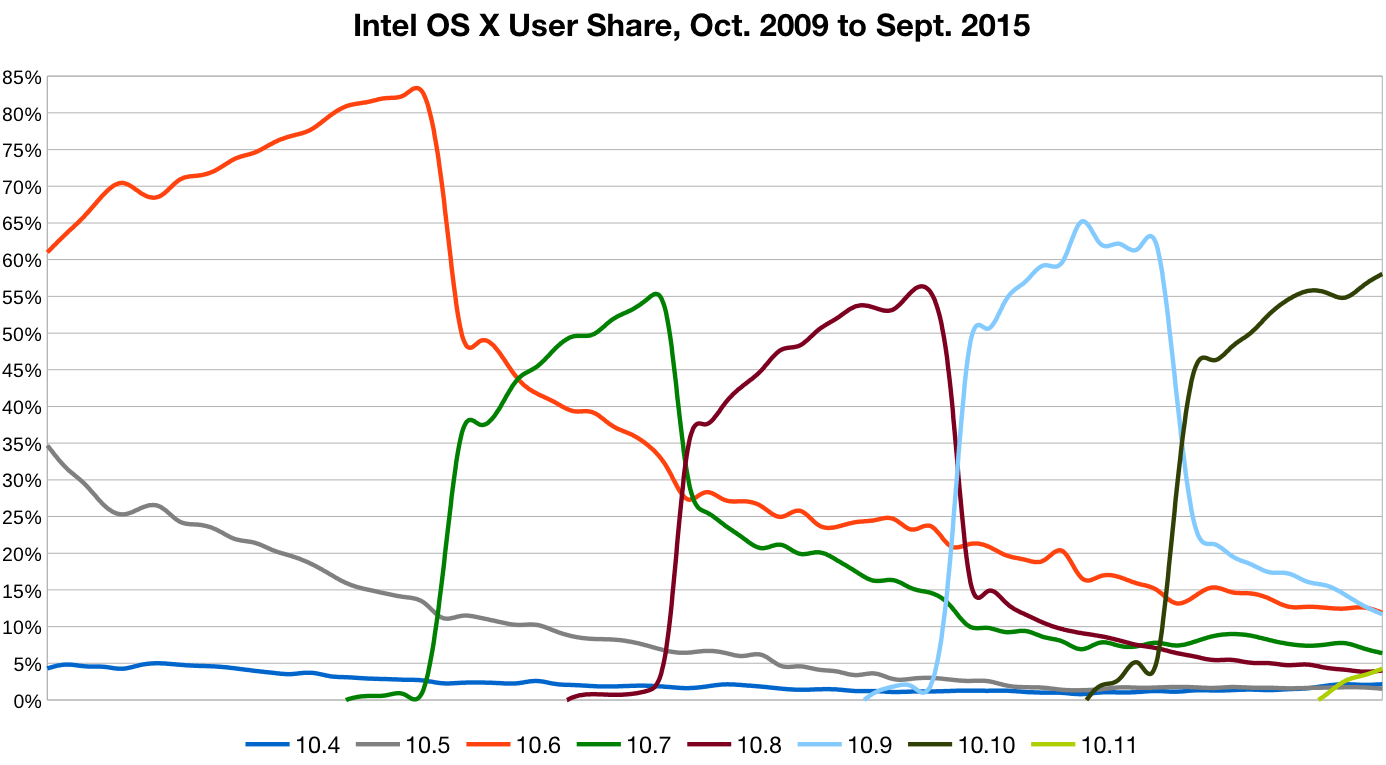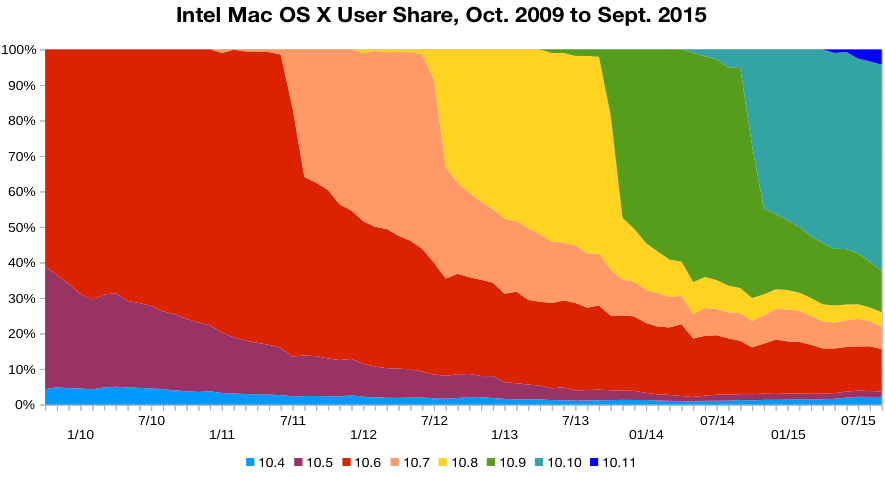Over time, the distribution of Mac OS versions among Mac users changes as new versions of the OS are released, old Macs are retired, and new models arrive that only support the most recent version. Today we’re looking at six years worth of data.
Bear in mind that this reflects visitors to lowendmac.com and is probably not reflective of the percentages of each version visiting a general interest site. That said, trends for each OS version should be similar.
The first graph shows the distribution of each version of Mac OS X on Intel-based Macs since OS X 10.4 Tiger over the period of October 2009 through September 2015. During that time, only one version of OS X has totally dominated the user base for an appreciable amount of time.
Tiger (introduced in April 2005, the first version of OS X for Intel Macs, and on the market for a record 2-1/2 years) was already down to 5% of those visiting lowendmac.com using Intel Macs, and OS X 10.5 Leopard – then two years old – was at 35% in October 2009.
Already at 62% share, OS X 10.6 Snow Leopard was in the ascent, having come to market in August 2009. It was the first version of OS X exclusive to Intel Macs, and users upgraded to it from Tiger and Leopard in droves. By the time it was replaced in July 2011, it had 83% share among Intel Mac users visiting Low End Mac. With nearly two years as the current OS X version, it takes second place only to Tiger in that department.
Starting in 2011, Apple made developer preview versions and sometimes also beta versions of the next revision of OS X available months before they were released to the public. Because of this, you’ll see a short low tail prior to release, and then the graph takes a big jump upward.
OS X 10.7 Lion arrived in July 2011, and there were some big changes in store for users. First of all, those with Core Duo and Core Solo Macs couldn’t use it, marking the first time a version of OS X had left behind any Intel Macs. Secondly, Lion no longer supported Rosetta, Apple’s technology that let Intel Macs continue to run PowerPC software. For those using AppleWorks or older versions of Microsoft Office, Photoshop, etc., it meant upgrading would not be cheap – adding the cost of OS X and software updates.
Regardless, within a couple months Lion had cut Snow Leopard’s share to below 50%, and Lion itself reached the 55% mark among user before it was replaced by the next big cat.
You’ll also notice in the graph that after an initial spike in the percentage of users, there is always a brief drop as some users choose to go back to an earlier version of OS X.
OS X 10.8 Mountain Lion, introduced in July 2012, also raised the hardware bar, and we are very fortunate that every version of OS X since has had the same system requirements. Mountain Lion cut Lion use in half almost immediately, and within a few months there were more OS X 10.6 users visiting Low End Mac than 10.7 users. From that point through the present, Lion has fallen further and further behind Snow Leopard, which remains surprisingly strong overall.
Mountain Lion peaked at 65%, then dipped a bit thanks to the heavily promoted OS X 10.9 Mavericks public beta. Mavericks was released in October 2013 as a free upgrade from OS X 10.6, 10.7, and 10.8, and it zoomed past the 50% mark in short order. With the same hardware requirements as 10.8 Mountain Lion, every Mountain Lion user could potentially make the switch – and for free.
Mavericks was one of only two versions of OS X to pass the 65% mark among users (based on our site stats), and it also had the highest adoption rate of any version of OS X for Intel Macs.
OS X 10.10 Yosemite was even more successful during its public beta period, but it didn’t take off as quickly as Mavericks had, nor did it reach the same level among users, topping out at 58% before OS X 10.11 El Capitan arrived to take its place as king of the OS X hill.
The next graph takes a different look at the same data. Each version of OS X is stacked on the previous one to display the data.
By their width, you can see that OS X 10.6 Snow Leopard and 10.8 Mountain Lion were the “current” version of OS X longer than were Lion and Mavericks. More than that, you can readily see how use of OS X 10.4 Tiger and 10.5 Leopard has faded away over time, both are now in the 2% range.
At present, OS X 10.10 Mavericks has the lion’s share among users at 58%, although that will change as this is El Capitan’s first full month on the market. In second place, although barely, is OS X 10.6 Snow Leopard, with 10.9 Mavericks just behind it – both at about 12%.
OS X 10.7 Lion comes in next at about 7%, most of those are probably users who cannot upgrade to OS X 10.8 Mountain Lion and later.
OS X 10.11 El Capitan has already surpassed Mountain Lion for the month of September 2012 – despite the fact that it was released on the last day of the month. Both 10.11 and 10.8 are at roughly 4%.
What About PowerPC Macs?
Over the six years of data we have, PowerPC Macs have gone from being 30% of our Mac users to now reaching the 10% mark. It’s not that a lot of old Macs are no longer in use, only that Apple has sold a heck of a lot more Intel Macs year after year, while the number of PowerPC Macs in service can do nothing but decline as they age.
Over the past six years, the percentage of PowerPC Mac users visiting lowendmac.com using OS X has had a remarkably even breakdown.
- 41% are using OS X 10.5 Leopard on their G4 and G5 Macs, with a low of 36% in /ate 2009/early 2010 to a high of 48% in 2012/13.
- 46% are using OS X 10.4 Tiger on their G3, G4, and G5 Macs, with numbers fluctuating between 43% and 50%.
- Overall, 14% are using earlier versions of OS X, with a high of 21% in 2010 and a low of 9% in late 2014/early 2015.
We don’t include PPC versions of OS X in our charts because they are a different market segment. As far as software development goes, PPC is practically dead in the water.
 TenFourFox (TFF), a fork of the latest extended release revision (ESR) of Firefox optimized for G3, G4, and G5 chips, is the only ongoing software project. It supports both Tiger and Leopard, and it runs very nicely – especially on G4 and G5 Macs, where it can use the AltiVec velocity engine. TenFourFox supports HTML5 and JavaScript, although it does leave Flash behind (to which many say good riddance). Most YouTube videos will run just fine with TFF.
TenFourFox (TFF), a fork of the latest extended release revision (ESR) of Firefox optimized for G3, G4, and G5 chips, is the only ongoing software project. It supports both Tiger and Leopard, and it runs very nicely – especially on G4 and G5 Macs, where it can use the AltiVec velocity engine. TenFourFox supports HTML5 and JavaScript, although it does leave Flash behind (to which many say good riddance). Most YouTube videos will run just fine with TFF.
Yes, you read it right. You can run ESR version 38.3 of Firefox on your old PPC Macs that have OS X 10.4 and 10.5 installed. It just has a different name, but it works the same. Even most Firefox add-ons will work!
That’s a huge step forward from the official Mac PowerPC version of Firefox for Tiger and Leopard, which ceased development at version 3.6.28 in 2012.
And What About Core Duo Macs?
Although newer versions of OS X have really upped the hardware requirements, OS X 10.6 Snow Leopard remains a solid option for those using Core Duo Macs with 2 GB of system memory or older, slower Macs with 2-4 GB. I’m writing this on a Mid 2007 Mac mini, a Core 2 Duo machine with 3 GB of RAM, and it has been running Snow Leopard very nicely for years – even moreso since I replaced a failing hard drive with a 250 GB Samsung 850 EVO SSD.
Although OS X Tiger and Leopard will run with less memory, they are far more outdated than Snow Leopard. Best of all, with Snow Leopard you can still run PowerPC software and possibly the current version of Google’s Chrome browser, the second most popular browser on Macs – if you have a Core 2 Duo Mac. (32-bit Core Duo Macs are not supported on Chrome 39 and later, but you can still download Chrome 38 Final for these Macs.)
You can run the current version of Firefox on any Mac running Snow Leopard.
More Browser Options for PPC and Core Duo Macs
Safari for OS X 10.4, 10.5, and 10.6 is very dated. Look at Firefox and Chrome as the best options to start looking for a more current browser. You might also want to consider these:
Opera has been around since 1995, making it one of the oldest browsers still in production. For Tiger or Leopard on PPC, you want version 10.63. With Intel and Tiger, you can run Opera 11. Intel and Leopard lets you run Opera 12. And if you’re running OS X 10.6 Snow Leopard or newer, you can run Opera 25. (The current release is version 32. All versions from 26 forward require OS X 10.7 Lion.)
OmniWeb was the first browser for Mac OS X, ported over from the NeXT version. The current release version is 5.11.2, which requires OS X 10.4.8 or later and supports both PPC and Intel.
I’ve become a real fan of Stainless, a multithreaded Mac browser that supports parallel sessions in different tabs or windows. You can even log into the same website with different IDs in different windows. It hasn’t been updated since 2013, but it runs nicely on OS X 10.5 and later, even on PowerPC Macs.
Camino is even older than Stainless. It started out as a port of Mozilla to Mac OS X, and it ended development with version 2.1.2 in March 2012. It runs very nicely on OS X 10.4 and later, and it’s quick so long as you only have a few tabs or windows open.
Shiira is another discontinued project (2009). It supports OS X 10.4.8 and later, so it’s an option. It was designed for speed.
iCab has an unusual history, being based on the CAB browser for Atari ST computers. Unlike the others, it’s $20 shareware that you can use for free for a limited time. I’ve been using it on and off since 1999, and . Version 2.9.9 supports the Classic Mac OS on 680×0 Macs running Mac OS 7.5 to 8.1. Version 3.0.5 (2008) requires a PowerPC processor and Mac OS 7.5 to 9.2.2. There is also a version 3.0.5 for OS X 10.1.5 to 10.5.
For the audience of this article, iCab 4.9 (2012) works with OS X 10.3.9 through 10.4.11, and 5.1.1 (2013) supports OS X 10.5 through 10.7. Those using OS X 10.6 Snow Leopard should consider iCab 5.2 (2014), which is compatible up to OS X 10.9.
Keywords: #macosxusershare #osxusershare #macosusershare
Short link: http://goo.gl/T6BR2M
searchword: osxusershare



